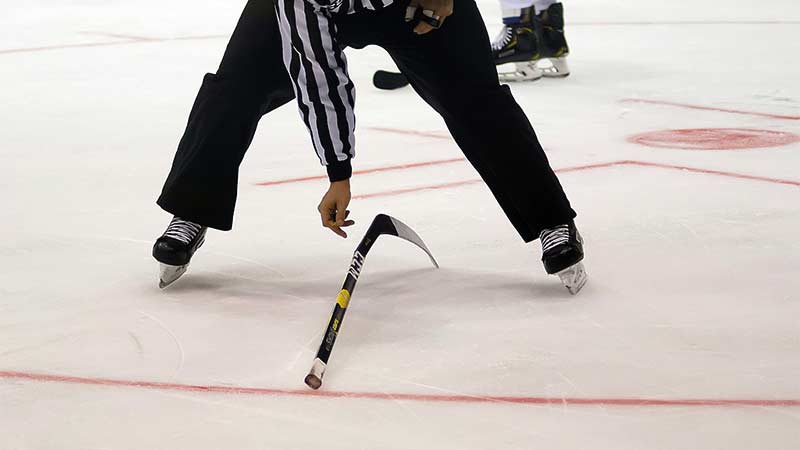Ever wondered why hockey players leave their sticks on the ice? It might seem strange at first, but there’s a good reason behind it.
Whether it’s an accidental drop or a strategic decision, players often abandon their sticks during the game. One key reason is that playing with a broken stick is illegal and can result in a two-minute minor penalty.
Players must drop their broken sticks immediately to avoid penalties. Another reason is positioning retrieving a stick can take a player out of position, giving the opponents a scoring opportunity. In a fast-paced game like hockey, staying in the right spot is crucial.
Understanding these reasons helps you appreciate the split-second decisions players make on the ice. Next time you see a stick left behind, you’ll know it’s all part of the game strategy.
The Basics of Ice Hockey
Ice hockey, a fast-paced and physical sport, requires players to make quick decisions that can impact the course of a game. Knowing the game’s fundamentals helps you appreciate why players act as they do during high-pressure moments.
The Role of the Hockey Stick
The hockey stick serves several key purposes for players. First, it’s the primary tool for shooting, passing, and controlling the puck.
Without it, players find themselves severely limited in their ability to contribute to their team’s offensive and defensive strategies.
The stick also aids in checking opponents and blocking shots. Players rely on the stick for balance and stability, enhancing maneuverability on the ice.
Losing or breaking the stick in the middle of a play often leaves players at a significant disadvantage, forcing them to quickly adapt or leave the ice.
Rules Impacting Stick Use
Strict rules govern the use of hockey sticks to ensure safety and fairness. Playing with a broken stick is prohibited, and doing so results in a two-minute minor penalty.
The penalty aims to prevent the dangers associated with sharp or fragmented parts, which could injure players or interfere with the game.
Referees expect players to immediately drop any broken equipment and head to the bench to avoid these risks. Additionally, rules forbid using a stick to trip, slash, or hook an opponent, ensuring fair play and reducing the risk of injury.
These regulations collectively maintain the sport’s integrity and protect players from potential harm.
Common Reasons for Leaving Sticks on the Ice
Leaving sticks on the ice is a common practice in hockey culture, often done as a sign of respect or remembrance for various reasons.
Here are some common reasons why players leave sticks on the ice:
Broken Stick During Play
Playing with a broken stick is illegal in hockey, leading to a 2-minute minor penalty if a player continues using it.
When a stick breaks, whether from a high-impact shot or a robust check, players must immediately drop it to avoid penalties.
You might have noticed the frequency of broken sticks during games, a consequence of both the increased physical strength of modern athletes and the manufacturing focus on shot velocity over durability.
The requirement to drop a broken stick ensures the game remains fair and safe, and players adapt quickly to this rule to avoid compromising their team’s performance.
Strategic Play and Positioning
Retrieving a stick during active play can mean leaving a critical position unattended, giving opponents a scoring opportunity.
Players often leave their sticks on the ice to maintain strategic positioning, ensuring their team isn’t left vulnerable. This tactic is crucial in situations where every player’s position impacts the defense or offense strategy.
For instance, a defenseman abandoning their spot to pick up a stick can create a gap that opponents can exploit.
Consequently, players prioritize their on-ice positioning over picking up their equipment, demonstrating the importance of strategy and quick decision-making in hockey.
Rules Related to Picking Up Sticks
Hockey rules prioritize continuous play and safety, meaning players should drop broken or lost sticks to avoid hazards. Although officials may occasionally move debris, their primary focus remains on the play’s integrity and flow.
You’ll observe that rules don’t explicitly mandate officials to pick up sticks unless they pose a direct threat to player safety. This non-interference approach helps maintain game pace while reducing unnecessary stoppages.
Understanding these rules highlights the balance between maintaining game integrity and addressing safety concerns, reflecting the complex dynamics that make hockey both rigorous and strategic.
Consequences of Leaving Sticks on the Ice
While leaving sticks on the ice can be a meaningful gesture in certain contexts, there are also potential consequences associated with this practice:
Safety Concerns
Leaving sticks on the ice poses significant safety risks. Players can trip over these abandoned sticks, leading to potential injuries. For example, collisions and falls often result when a player unintentionally skates over or around a misplaced stick.
The NHL acknowledged this by actively encouraging officials to remove sticks from play areas as quickly as possible to minimize hazards.
If a player gets tangled in a stick during a high-speed play, the risk of injury escalates, potentially impacting their performance and the game’s outcome.
Impact on Game Flow
Abandoned sticks disrupt the game’s fluidity. The constant need to avoid debris affects both offensive and defensive strategies, as players must navigate around these obstacles.
For instance, a forward driving towards the net might lose a scoring chance if they trip over a stick, breaking the momentum.
Additionally, officials stopping play to clear sticks can lead to frequent game interruptions, disrupting the overall experience for players and fans.
Continuous and smooth game flow is essential in maintaining the excitement and integrity of hockey.
Player Strategies and Stick Handling
Player strategies and stick handling techniques are fundamental aspects of hockey gameplay, contributing to a player’s effectiveness on the ice.
Here are some strategies and techniques players commonly employ:
Goalie Stick Handling Exceptions
Goalies face unique challenges when handling their sticks. During a game, if a goalie’s stick breaks, they can’t simply drop it due to its critical role in blocking shots.
A common strategy involves a teammate passing the goalie a replacement stick, often their own, until a proper goalie stick can be secured.
This quick act prevents the goalie from becoming a liability in the net. Players understand the penalty risks associated with goalies playing without sticks, making this exception essential in gameplay.
Defense and Offense Strategies
Defensive and offensive strategies also reflect considerations surrounding stick handling. Defensively, players may leave a broken stick on the ice to avoid a penalty, as per NHL rules, which mandate immediate discarding of broken equipment.
This ensures the player continues to contribute to the team’s defense even without a stick. Offensively, positioning often dictates decisions about broken sticks.
If a stick shatters during rushes or around the net, maintaining skater placement takes priority over clearing debris. This helps sustain offensive pressure and scoring opportunities.
Players adapt quick, strategic responses to stick breakage, ensuring minimal disruption while adhering to rules and safety protocols.
This blend of strategy and compliance shapes how hockey players handle and leave sticks on the ice during high-stakes moments.
Frequently Asked Questions
Are there different rules for goalies regarding stick handling?
Yes, goalies have exceptions regarding stick handling. They are allowed quick replacements of broken sticks to avoid penalties and maintain their effectiveness in the game.
How do abandoned sticks impact gameplay and safety?
Abandoned sticks can be hazardous and disruptive. The NHL encourages officials to swiftly remove them to minimize risk and maintain the flow of the game.
Why is the placement of a player’s stick important in hockey?
Having their sticks on the ice helps players gain quick control of the puck and react swiftly during the fast-paced gameplay. It ensures they are always ready to engage in play.
What safety protocols are in place for handling broken sticks?
Players must drop broken sticks immediately, and officials work to remove these from the ice quickly. This minimizes the risk of injury and disruptions during the game.
Conclusion
Understanding why hockey players leave their sticks on the ice reveals the intricate balance between strategy, safety, and game flow.
Players’ quick decisions, whether it’s to avoid penalties or adapt to broken equipment, showcase the sport’s dynamic nature. The NHL’s proactive measures ensure minimal disruptions and maintain safety standards.
These elements underscore the critical role of sticks and the swift adaptability required in hockey. This practice also highlights the continuous evolution of the game as players and officials work together to uphold competitive integrity.
By examining these nuances, fans gain a deeper appreciation for the sport’s complexities and the skill involved.








James Felix